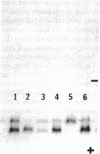Abstract
Skin fibroblasts of human males affected with adrenoleukodystrophy (ALD) have previously been shown to be abnormal with respect to C26 fatty acid content. Skin fibroblast clones from heterozygotes in three families segregating this mutation have been analyzed and are of two types: clones with normal ratios of C26 to C22 fatty acids and clones with an excess of C26 fatty acids similar to that found in cells of affected males. This indicates not only that the locus is X linked but also that it is subject to inactivation. In most of the heterozygotes there were significantly more clones of abnormal type than those expressing the normal allele, indicating a proliferative advantage in vitro for skin fibroblasts of mutant type. The increased levels of fatty acids in plasma in most heterozygotes and the phenotype of blood cells of women heterozygous for both ALD and glucose-6-phosphate dehydrogenase (G6PD) in one family are evidence that selection favoring the mutant allele may occur in vivo as well as in vitro and may explain why many heterozygotes manifest clinical symptoms of the disease. These studies have also revealed the close linkage between ALD and G6PD loci, because there are no recombinants among 18 informative offspring of doubly heterozygous mothers. Therefore, the ALD locus can be mapped on the human X chromosome near the G6PD locus at Xq28.
Full text
PDF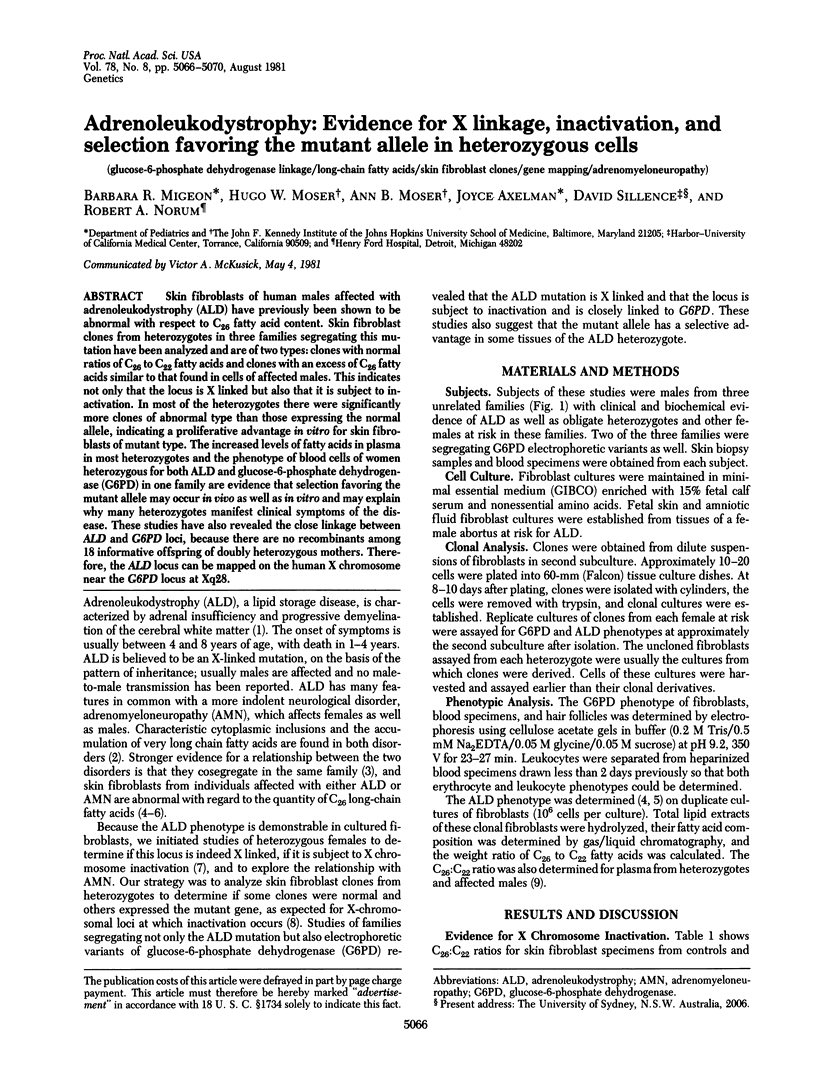
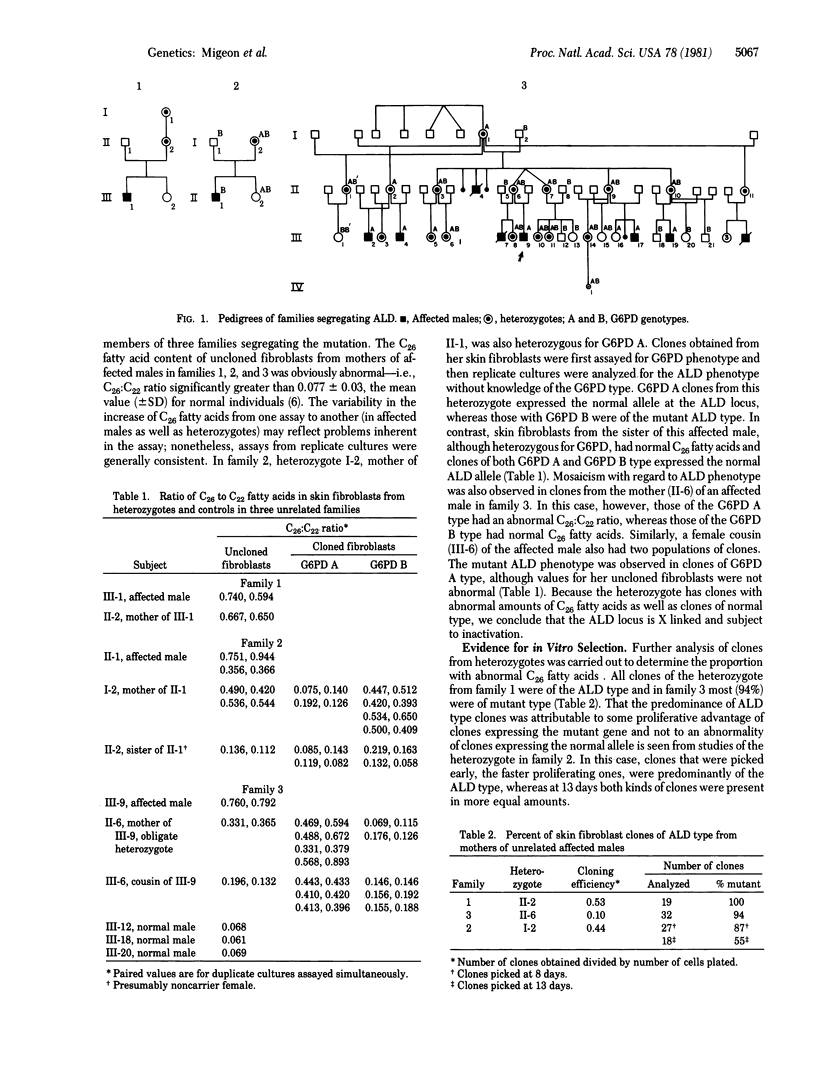
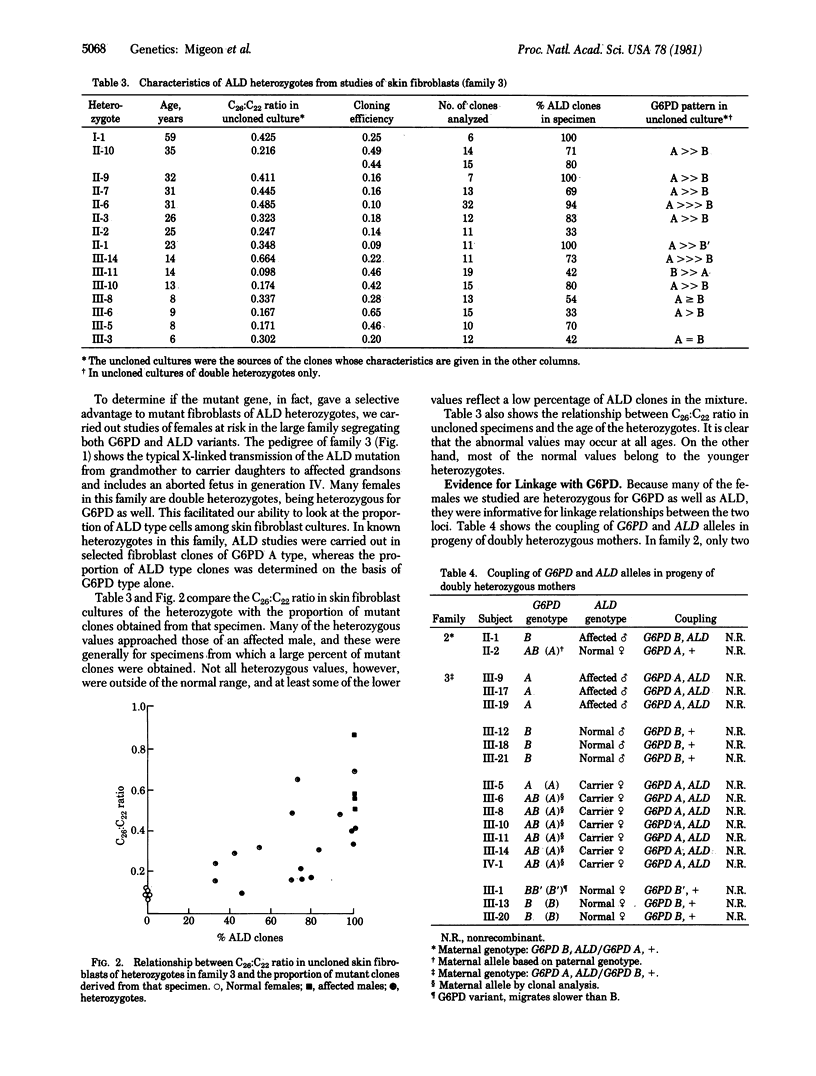
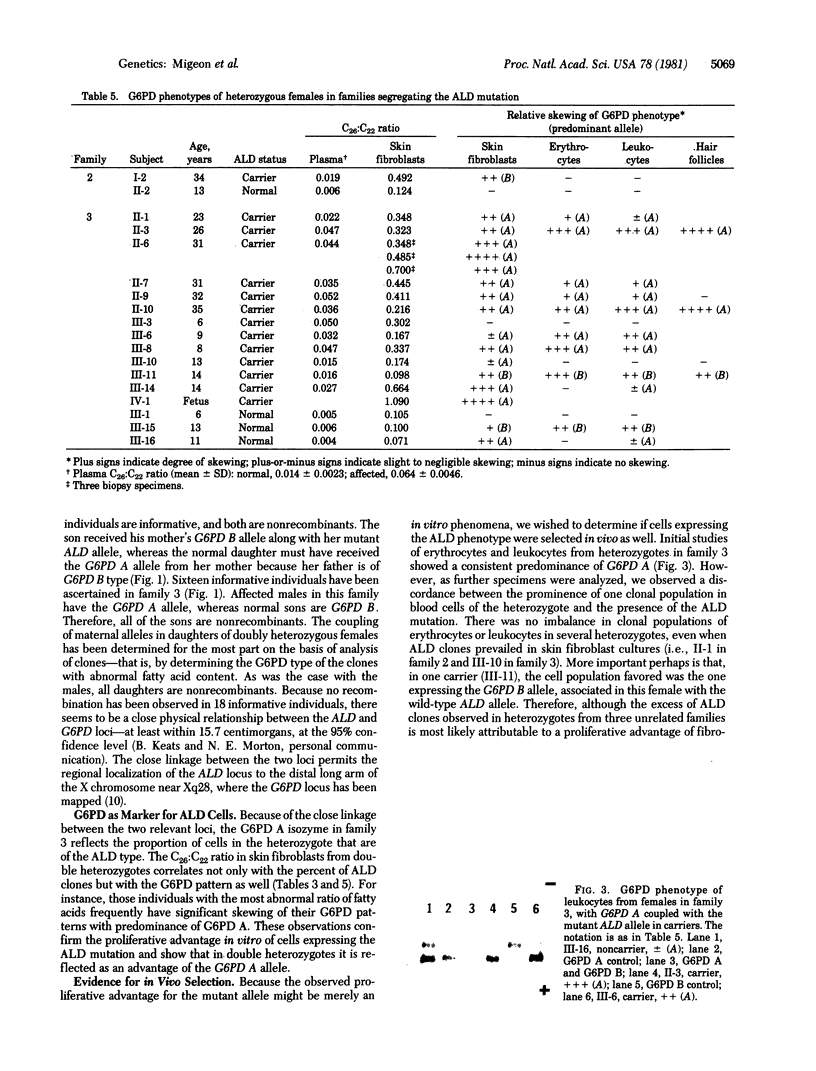
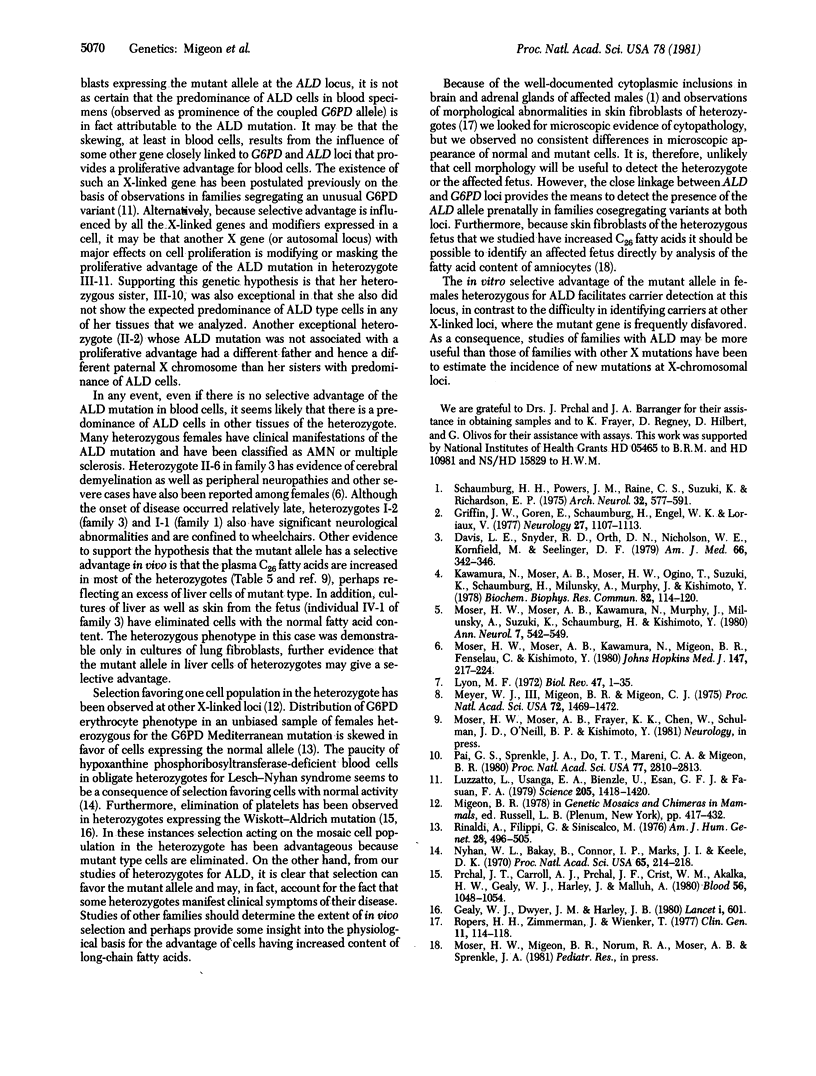
Images in this article
Selected References
These references are in PubMed. This may not be the complete list of references from this article.
- Davis L. E., Snyder R. D., Orth D. N., Nicholson W. E., Kornfeld M., Seelinger D. F. Adrenoleukodystrophy and adrenomyeloneuropathy associated with partial adrenal insufficiency in three generations of a kindred. Am J Med. 1979 Feb;66(2):342–347. doi: 10.1016/0002-9343(79)90562-x. [DOI] [PubMed] [Google Scholar]
- Griffin J. W., Goren E., Schaumburg H., Engel W. K., Loriaux L. Adrenomyeloneuropathy: a probable variant of adrenoleukodystrophy. I. Clinical and endocrinologic aspects. Neurology. 1977 Dec;27(12):1107–1113. doi: 10.1212/wnl.27.12.1107. [DOI] [PubMed] [Google Scholar]
- Kawamura N., Moser A. B., Moser H. W., Ogino T., Suzuki K., Schaumburg H., Milunsky A., Murphy J., Kishimoto Y. High concentration of hexacosanoate in cultured skin fibroblast lipids from adrenoleukodystrophy patients. Biochem Biophys Res Commun. 1978 May 15;82(1):114–120. doi: 10.1016/0006-291x(78)90584-3. [DOI] [PubMed] [Google Scholar]
- Luzzatto L., Usanga E. A., Bienzle U., Esan G. F., Fusuan F. A. Imbalance in X-chromosome expression: evidence for a human X-linked gene affecting growth of hemopoietic cells. Science. 1979 Sep 28;205(4413):1418–1420. doi: 10.1126/science.472761. [DOI] [PubMed] [Google Scholar]
- Lyon M. F. X-chromosome inactivation and developmental patterns in mammals. Biol Rev Camb Philos Soc. 1972 Jan;47(1):1–35. doi: 10.1111/j.1469-185x.1972.tb00969.x. [DOI] [PubMed] [Google Scholar]
- Meyer W. J., 3rd, Migeon B. R., Migeon C. J. Locus on human X chromosome for dihydrotestosterone receptor and androgen insensitivity. Proc Natl Acad Sci U S A. 1975 Apr;72(4):1469–1472. doi: 10.1073/pnas.72.4.1469. [DOI] [PMC free article] [PubMed] [Google Scholar]
- Migeon B. R. Selection and cell communication as determinants of female phenotype. Basic Life Sci. 1978;12:417–432. doi: 10.1007/978-1-4684-3390-6_28. [DOI] [PubMed] [Google Scholar]
- Moser H. W., Moser A. B., Kawamura N., Migeon B., O'Neill B. P., Fenselau C., Kishimoto Y. Adrenoleukodystrophy: studies of the phenotype, genetics and biochemistry. Johns Hopkins Med J. 1980 Dec;147(6):217–224. [PubMed] [Google Scholar]
- Moser H. W., Moser A. B., Kawamura N., Murphy J., Suzuki K., Schaumburg H., Kishimoto Y. Adrenoleukodystrophy: elevated C26 fatty acid in cultured skin fibroblasts. Ann Neurol. 1980 Jun;7(6):542–549. doi: 10.1002/ana.410070607. [DOI] [PubMed] [Google Scholar]
- Nyhan W. L., Bakay B., Connor J. D., Marks J. F., Keele D. K. Hemizygous expression of glucose-6-phosphate dehydrogenase in erythrocytes of heterozygotes for the Lesch-Nyhan syndrome. Proc Natl Acad Sci U S A. 1970 Jan;65(1):214–218. doi: 10.1073/pnas.65.1.214. [DOI] [PMC free article] [PubMed] [Google Scholar]
- Pai G. S., Sprenkle J. A., Do T. T., Mareni C. E., Migeon B. R. Localization of loci for hypoxanthine phosphoribosyltransferase and glucose-6-phosphate dehydrogenase and biochemical evidence of nonrandom X chromosome expression from studies of a human X-autosome translocation. Proc Natl Acad Sci U S A. 1980 May;77(5):2810–2813. doi: 10.1073/pnas.77.5.2810. [DOI] [PMC free article] [PubMed] [Google Scholar]
- Prchal J. T., Carroll A. J., Prchal J. F., Crist W. M., Skalka H. W., Gealy W. J., Harley J., Malluh A. Wiskott-Aldrich syndrome: cellular impairments and their implication for carrier detection. Blood. 1980 Dec;56(6):1048–1054. [PubMed] [Google Scholar]
- Rinaldi A., Filippi G., Siniscalco M. Variability of red cell phenotypes between and within individuals in an unbiased sample of 77 heterozygotes for G6PD deficiency in Sardinia. Am J Hum Genet. 1976 Sep;28(5):496–505. [PMC free article] [PubMed] [Google Scholar]
- Ropers H. H., Zimmermann J., Wienker T. Adrenoleukodystrophy (Siemerling-creutzfeldt disease): Heterozygote with two clonal fibroblast populations. Clin Genet. 1977 Feb;11(2):114–118. doi: 10.1111/j.1399-0004.1977.tb01287.x. [DOI] [PubMed] [Google Scholar]
- Schaumburg H. H., Powers J. M., Raine C. S., Suzuki K., Richardson E. P., Jr Adrenoleukodystrophy. A clinical and pathological study of 17 cases. Arch Neurol. 1975 Sep;32(9):577–591. doi: 10.1001/archneur.1975.00490510033001. [DOI] [PubMed] [Google Scholar]



